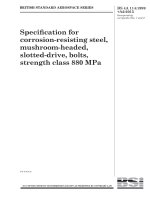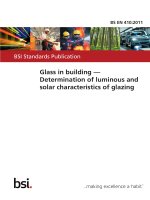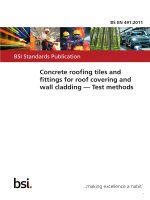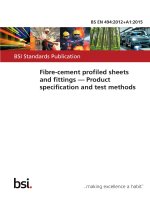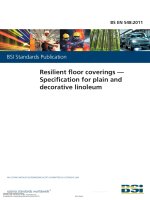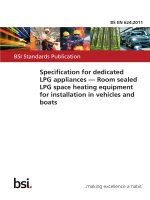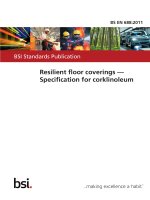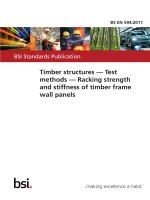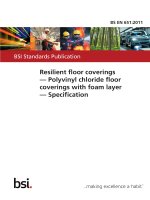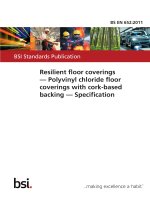Bsi bs en 61199 2011 + a2 2015
Bạn đang xem bản rút gọn của tài liệu. Xem và tải ngay bản đầy đủ của tài liệu tại đây (1.82 MB, 48 trang )
BS EN 61199:2011+A2:2015
BSI Standards Publication
Single-capped fluorescent
lamps — Safety specifications
BRITISH STANDARD
BS EN 61199:2011+A2:2015
National foreword
This British Standard is the UK implementation of
EN 61199:2011+A2:2015. It is identical to IEC 61199:2011, incorporating
amendment 1:2012 and amendment 2:2014. It supersedes
BS EN 61199:2011+A1:2013, which is withdrawn.
The start and finish of text introduced or altered by amendment is
indicated in the text by tags. Tags indicating changes to IEC text carry
the number of the IEC amendment. For example, text altered by IEC
amendment 1 is indicated by !".
The UK participation in its preparation was entrusted by Technical
Committee CPL/34, Lamps and Related Equipment, to subcommittee
CPL/34/1, Electric lamps.
A list of organizations represented on this subcommittee can be
obtained on request to its secretary.
This publication does not purport to include all the necessary provisions
of a contract. Users are responsible for its correct application.
© The British Standards Institution 2015.
Published by BSI Standards Limited 2015
ISBN 978 0 580 83745 6
ICS 29.140.30
Compliance with a British Standard cannot confer immunity from
legal obligations.
This British Standard was published under the authority of the
Standards Policy and Strategy Committee on 30 September 2011.
Amendments/corrigenda issued since publication
Date
Text affected
31 May 2013
Implementation of IEC amendment 1:2012 with
CENELEC endorsement A1:2013
28 February 2015
Implementation of IEC amendment 1:2014 with
CENELEC endorsement A2:2015
EUROPEAN STANDARD
EN 61199:2011+A2
NORME EUROPÉENNE
January 2015
EUROPÄISCHE NORM
ICS 29.140.30
English version
Single-capped fluorescent lamps Safety specifications
(IEC 61199:2011)
Lampes à fluorescence à culot unique Specifications de sécurité
(CEI 61199:2011)
Einseitig gesockelte Leuchtstofflampen Sicherheitsanforderungen
(IEC 61199:2011)
This European Standard was approved by CENELEC on 2011-08-15. CENELEC members are bound to comply
with the CEN/CENELEC Internal Regulations which stipulate the conditions for giving this European Standard
the status of a national standard without any alteration.
Up-to-date lists and bibliographical references concerning such national standards may be obtained on
application to the Central Secretariat or to any CENELEC member.
This European Standard exists in three official versions (English, French, German). A version in any other
language made by translation under the responsibility of a CENELEC member into its own language and notified
to the Central Secretariat has the same status as the official versions.
CENELEC members are the national electrotechnical committees of Austria, Belgium, Bulgaria, Croatia, Cyprus,
the Czech Republic, Denmark, Estonia, Finland, France, Germany, Greece, Hungary, Iceland, Ireland, Italy,
Latvia, Lithuania, Luxembourg, Malta, the Netherlands, Norway, Poland, Portugal, Romania, Slovakia, Slovenia,
Spain, Sweden, Switzerland and the United Kingdom.
CENELEC
European Committee for Electrotechnical Standardization
Comité Européen de Normalisation Electrotechnique
Europäisches Komitee für Elektrotechnische Normung
Management Centre: Avenue Marnix 17, B - 1000 Brussels
© 2011 CENELEC -
All rights of exploitation in any form and by any means reserved worldwide for CENELEC members.
Ref. No. EN 61199:2011 E
BS EN 61199:2011+A2:2015
EN 61199:2011+A2:2015 (E)
-2-
Foreword
The text of document 34A/1468/FDIS, future edition 3 of IEC 61199, prepared by SC 34A, "Lamps", of
IEC TC 34, "Lamps and related equipment" was submitted to the IEC-CENELEC parallel vote and
approved by CENELEC as EN 61199:2011.
The following dates are fixed:
•
•
latest date by which the document has
to be implemented at national level by
publication of an identical national
standard or by endorsement
latest date by which the national
standards conflicting with the
document have to be withdrawn
(dop)
2012-05-15
(dow)
2014-08-15
This document supersedes EN 61199:1999.
Main technical changes are the introduction of requirements for high frequency operation, a new
temperature measurement position and few new cap-holder fits.
Attention is drawn to the possibility that some of the elements of this document may be the subject of
patent rights. CENELEC [and/or CEN] shall not be held responsible for identifying any or all such patent
rights.
Endorsement notice
The text of the International Standard IEC 61199:2011 was approved by CENELEC as a European
Standard without any modification.
In the official version, for Bibliography, the following note has to be added for the standard indicated:
IEC 62471
NOTE Harmonized as EN 62471.
Foreword to amendment A1
The text of document 34A/1538/CDV, future edition 1 of IEC 61199:2011/A1, prepared by SC 34A,
"Lamps", of IEC TC 34, "Lamps and related equipment" was submitted to the IEC-CENELEC parallel vote
and approved by CENELEC as EN 61199:2011/A1:2013.
The following dates are fixed:
•
•
latest date by which the document has
to be implemented at national level by
publication of an identical national
standard or by endorsement
latest date by which the national
standards conflicting with the
document have to be withdrawn
(dop)
2013-08-22
(dow)
2015-11-01
Attention is drawn to the possibility that some of the elements of this document may be the subject of
patent rights. CENELEC [and/or CEN] shall not be held responsible for identifying any or all such patent
rights.
This standard covers the Principle Elements of the Safety Objectives for Electrical Equipment Designed
for Use within Certain Voltage Limits (LVD - 2006/95/EC).
Endorsement notice
The text of the International Standard IEC 61199:2011/A1:2012 was approved by CENELEC as a
European Standard without any modification.
-3-
BS EN 61199:2011+A2:2015
EN 61199:2011+A2:2015 (E)
Foreword to amendment A2
The text of document 34A/1740/CDV, future IEC 61199:2011/A2, prepared by SC 34A “Lamps” of
IEC/TC 34 “Lamps and related equipment" was submitted to the IEC-CENELEC parallel vote and
approved by CENELEC as EN 61199:2011/A2:2015.
The following dates are fixed:
•
latest date by which the document has to be
implemented at national level by
publication of an identical national
standard or by endorsement
(dop)
2015-07-16
•
latest date by which the national
standards conflicting with the
document have to be withdrawn
(dow)
2017-09-03
Attention is drawn to the possibility that some of the elements of this document may be the subject of
patent rights. CENELEC [and/or CEN] shall not be held responsible for identifying any or all such
patent rights.
This standard covers the Principle Elements of the Safety Objectives for Electrical Equipment
Designed for Use within Certain Voltage Limits (LVD - 2006/95/EC).
Endorsement notice
The text of the International Standard IEC 61199:2011/A2:2014 was approved by CENELEC as a
European Standard without any modification.
BS EN 61199:2011+A2:2015
EN 61199:2011+A2:2015 (E)
-4-
Annex ZA
(normative)
Normative references to international publications
with their corresponding European publications
The following referenced documents are indispensable for the application of this document. For dated
references, only the edition cited applies. For undated references, the latest edition of the referenced
document (including any amendments) applies.
NOTE When an international publication has been modified by common modifications, indicated by (mod), the relevant EN/HD
applies.
Publication
Year
Title
EN/HD
IEC 60061-1
-
Lamp caps and holders together with gauges EN 60061-1
for the control of interchangeability
and safety Part 1: Lamp caps
-
IEC 60061-2
-
Lamp caps and holders together with gauges EN 60061-2
for the control of interchangeability
and safety Part 2: Lampholders
-
IEC 60061-3
-
Lamp caps and holders together with gauges EN 60061-3
for the control of interchangeability
and safety Part 3: Gauges
-
IEC 60061-4
-
Lamp caps and holders together with gauges EN 60061-4
for the control of interchangeability
and safety Part 4: Guidelines and general information
-
IEC 60155
-
Glow-starters for fluorescent lamps
EN 60155
-
IEC 60360
-
Standard method of measurement of lamp
cap temperature rise
EN 60360
-
IEC 60410
-
Sampling plans and procedures for inspection by attributes
-
IEC 60529
-
Degrees of protection provided by enclosures (IP Code)
-
IEC 60598-1 (mod) 2008
-
Luminaires Part 1: General requirements and tests
2008
2009
IEC 60695-2-10
-
Fire hazard testing EN 60695-2-10
Part 2-10: Glowing/hot-wire based test
methods - Glow-wire apparatus and common
test procedure
-
IEC 60901
-
Single-capped fluorescent lamps Performance specifications
-
IEC 61347-2-3
-
Lamp controlgear EN 61347-2-3
Part 2-3: Particular requirements for a.c.
and/or d.c. supplied electronic control gear for
fluorescent lamps
-
IEC 61347-2-8
-
Lamp controlgear Part 2-8: Particular requirements for ballasts
for fluorescent lamps
-
EN 60598-1
+ A11
EN 60901
EN 61347-2-8
Year
BS EN 61199:2011+A2:2015
IEC 61199:2011+A2:2014 (E)
–2–
CONTENTS
FOREWORD ........................................................................................................................... 4
INTRODUCTION ..................................................................................................................... 6
1
Scope ............................................................................................................................... 7
2
Normative references........................................................................................................ 8
3
Terms and definitions ....................................................................................................... 8
4
Safety requirements ........................................................................................................ 10
4.1
4.2
4.3
5
General ................................................................................................................. 10
Marking ................................................................................................................. 10
Mechanical requirements for caps .......................................................................... 10
4.3.1 Construction and assembly ........................................................................ 10
4.3.2 Dimensional requirements for caps ............................................................ 10
4.3.3 Pin connections and keying configurations ................................................. 11
4.4 Insulation resistance .............................................................................................. 11
4.5 Electric strength .................................................................................................... 11
4.6 Parts which can become accidentally live ............................................................... 11
4.7 Resistance to heat and fire .................................................................................... 12
4.8 Creepage distance for caps ................................................................................... 13
4.9 Lamp cap temperature rise .................................................................................... 13
4.10 Radio interference suppression capacitors ............................................................. 14
4.10.1 General ..................................................................................................... 14
4.10.2 Moisture resistance .................................................................................... 14
4.10.3 Resistance to flame and ignition ................................................................. 15
4.11 UV radiation .......................................................................................................... 15
4.12 Information for luminaire design ............................................................................. 15
4.13 Information for ballast design ................................................................................. 15
4.14 Information for lampholder design .......................................................................... 15
Assessment .................................................................................................................... 15
5.1
5.2
5.3
5.4
5.5
5.6
Annex A
General ................................................................................................................. 15
Whole production assessment by means of the manufacturer’s records ................. 16
Assessment of the manufacturer’s records of particular tests ................................. 20
Rejection conditions of batches .............................................................................. 20
Sampling procedures for whole production testing .................................................. 21
Sampling procedures for batch testing ................................................................... 21
(normative) Tests for assessing caps for construction and assembly ....................... 23
Annex B (normative) Maximum lamp cap temperature rise values and method of
measurement ........................................................................................................................ 24
Annex C (informative) Information for luminaire design ......................................................... 30
Annex D (normative) Conditions of compliance for design tests ............................................ 32
Annex E (normative) Cathode connection configurations ...................................................... 33
Annex F (normative) Normal and abnormal lamp operation, lamp non-interchangeability
requirements ......................................................................................................................... 35
Annex G (normative) Information for thermal tests ................................................................ 37
Annex H (informative) Information for ballast design ............................................................. 38
Annex I (informative) Information for lampholder design ....................................................... 39
Bibliography .......................................................................................................................... 41
BS EN 61199:2011+A2:2015
IEC 61199:2011+A2:2014 (E)
–3–
Figure 1 – Places where to measure the temperature ............................................................ 14
Figure B.1 – Example for a test circuit for the measurement of the cap temperature rise
at maximum discharge current and maximum SoS ................................................................. 25
Figure B.2 – Examples where to measure the temperature according to Clause B.2 ............... 27
Figure E.1 – Where to connect the cathodes of different caps ................................................ 34
Figure G.1 – Ball-pressure apparatus .................................................................................... 37
Table 1 – Sheet references of IEC 60061 ................................................................................ 7
Table 2 – Grouping of test records – Sampling and acceptable quality levels (AQL) ............... 17
Table 3 – Acceptance numbers AQL = 0,65 % ....................................................................... 18
Table 4 – Acceptance numbers AQL = 2,5 % ......................................................................... 19
Table 5 – Batch sample size and rejection number ................................................................ 21
Table B.1 – Maximum cap temperature rise, lamps with internal or external starter (test
at abnormal operating conditions) .......................................................................................... 28
Table B.2 – Maximum cap temperature rise, lamps for starterless operation (test at
normal operating conditions) ................................................................................................. 29
Table C.1 – Maximum cap temperature, lamps with internal or external starter (test at
abnormal operating conditions).............................................................................................. 30
Table C.2 – Maximum cap temperature, lamps for starterless operation (test at
normal operating conditions) ................................................................................................. 31
Table F.1 – Maximum allowable currents and rated lamp power ............................................. 36
Table G.1 – Test temperatures .............................................................................................. 37
Table I.1 – Temperature point ............................................................................................... 39
Table I.2 – Maximum temperatures related to lampholder design ........................................... 40
BS EN 61199:2011+A2:2015
IEC 61199:2011+A2:2014 (E)
–4–
INTERNATIONAL ELECTROTECHNICAL COMMISSION
____________
SINGLE-CAPPED FLUORESCENT LAMPS –
SAFETY SPECIFICATIONS
FOREWORD
1) The International Electrotechnical Commission (IEC) is a worldwide organization for standardization comprising
all national electrotechnical committees (IEC National Committees). The object of IEC is to promote
international co-operation on all questions concerning standardization in the electrical and electronic fields. To
this end and in addition to other activities, IEC publishes International Standards, Technical Specifications,
Technical Reports, Publicly Available Specifications (PAS) and Guides (hereafter referred to as “IEC
Publication(s)”). Their preparation is entrusted to technical committees; any IEC National Committee interested
in the subject dealt with may participate in this preparatory work. International, governmental and nongovernmental organizations liaising with the IEC also participate in this preparation. IEC collaborates closely
with the International Organization for Standardization (ISO) in accordance with conditions determined by
agreement between the two organizations.
2) The formal decisions or agreements of IEC on technical matters express, as nearly as possible, an international
consensus of opinion on the relevant subjects since each technical committee has representation from all
interested IEC National Committees.
3) IEC Publications have the form of recommendations for international use and are accepted by IEC National
Committees in that sense. While all reasonable efforts are made to ensure that the technical content of IEC
Publications is accurate, IEC cannot be held responsible for the way in which they are used or for any
misinterpretation by any end user.
4) In order to promote international uniformity, IEC National Committees undertake to apply IEC Publications
transparently to the maximum extent possible in their national and regional publications. Any divergence
between any IEC Publication and the corresponding national or regional publication shall be clearly indicated in
the latter.
5) IEC itself does not provide any attestation of conformity. Independent certification bodies provide conformity
assessment services and, in some areas, access to IEC marks of conformity. IEC is not responsible for any
services carried out by independent certification bodies.
6) All users should ensure that they have the latest edition of this publication.
7) No liability shall attach to IEC or its directors, employees, servants or agents including individual experts and
members of its technical committees and IEC National Committees for any personal injury, property damage or
other damage of any nature whatsoever, whether direct or indirect, or for costs (including legal fees) and
expenses arising out of the publication, use of, or reliance upon, this IEC Publication or any other IEC
Publications.
8) Attention is drawn to the Normative references cited in this publication. Use of the referenced publications is
indispensable for the correct application of this publication.
9) Attention is drawn to the possibility that some of the elements of this IEC Publication may be the subject of
patent rights. IEC shall not be held responsible for identifying any or all such patent rights.
International Standard IEC 61199 has been prepared by subcommittee 34A: Lamps, of IEC
technical committee 34: Lamps and related equipment.
The text of this standard is based on the following documents:
FDIS
Report on voting
34A/1468/FDIS
34A/1493/RVD
Full information on the voting for the approval of this standard can be found in the report on
voting indicated in the above table.
This third edition cancels and replaces the second edition published in 1999. It constitutes a
technical revision. Main technical changes are the introduction of requirements for high
frequency operation, a new temperature measurement position and few new cap-holder fits.
This publication has been drafted in accordance with the ISO/IEC Directives, Part 2.
BS EN 61199:2011+A2:2015
IEC 61199:2011+A2:2014 (E)
–5–
The committee has decided that the contents of this publication will remain unchanged until the
stability date indicated on the IEC web site under "" in the data related to
the specific publication. At this date, the publication will be
•
•
•
•
reconfirmed,
withdrawn,
replaced by a revised edition, or
amended.
BS EN 61199:2011+A2:2015
IEC 61199:2011+A2:2014 (E)
–6–
INTRODUCTION
For the ease of measurement, a new location for measuring the maximum cap temperature
and maximum cap temperature rise has been introduced with this third edition of this standard,
resulting in new temperature values. However, the design of lampholders is based on the
traditional measurement location. Therefore, a new Annex I has been introduced, providing the
previous methods and values for those lamp types and kinds of lamp operation, which have
been already covered in the previous edition of this standard. For lamps, which are operated by
means of an electronic ballast however, also a new measurement method and temperature
limits are given.
Special attention has been given to the requirements related to high frequency operation, not
covered in the previous edition.
! The standards IEC 62471,and IEC/TR 62471-2, contain horizontal requirements available that
need to be introduced into product standards, e.g. to IEC 61199.
The horizontal requirements are transformed into requirements for single-capped fluorescent
lamps.
The lamps within the scope of this standard are general lighting service (GLS) lamps
according to the definition 3.11 of IEC 62471;2006. "...lamps intended for lighting spaces that
are typically occupied or viewed by people..."
According to Clause 6 of IEC 62471:2006, radiation of GLS lamps is measured at a distance
equivalent to 500 lx.
Measured at the 500 lx distance, GLS lamps will not exceed risk group 1 for blue light hazard
and risk group 0 for IR radiation. This combination of risk group and hazard does not require
marking (Table 1 of IEC/TR 62471-2:2009).
Hazards from UV radiation of GLS lamps are sufficiently covered in 4.11 of IEC 61199,.
Hence, IEC 62471 does not require any additional marking for GLS lamps. "
BS EN 61199:2011+A2:2015
IEC 61199:2011+A2:2014 (E)
–7–
SINGLE-CAPPED FLUORESCENT LAMPS –
SAFETY SPECIFICATIONS
1
Scope
This International Standard specifies the safety requirements for single-capped fluorescent
lamps for general lighting purposes of all groups having caps according to Table 1.
It also specifies the method a manufacturer should use to show compliance with the
requirements of this standard on the basis of whole production appraisal in association with his
test records on finished products. This method can also be applied for certification purposes.
Details of a batch test procedure which can be used to make limited assessment of batches
are also given in this standard.
! This part of the standard covers photobiological safety according to IEC 62471 and
IEC/TR 62471-2.
Blue light and infrared hazards are below the level which requires marking. "
NOTE Compliance with this standard concerns only safety criteria and does not take into account the performance
of single-capped fluorescent lamps for general lighting purposes with respect to luminous flux, colour, starting and
operational characteristics. For this information, readers are referred to IEC 60901.
Table 1 – Sheet references of IEC 60061
Sheet numbers
Cap type
IEC 60061-1
IEC 60061-3
Lamp caps
Cap gauges
2G7
7004-102
7006-102
2GX7
7004-103
7006-102
2G8
7004-141
7006-141, 141H, 141J, 141K
GR8
7004-68
7006-68A, 68B, 68E
G10q
7004-54
7006-79
GR10q
7004-77
7006-77A, 68B, 68E
GU10q
7004-123
7006-123, 123A
GX10q
7004-84
7006-79, 84, 84A and 84B
GY10q
7004-85
7006-79, 85 and 85A
GZ10q
7004-124
7006-79
2G10
7004-118
7006-118
2G11
7004-82
7006-82
2GX11-1
7004-82A
7006-82F, 82G, 82H
2GX13
7004-125
7006-125A, 125B
G23
7004-69
7006-69
GX23
7004-86
7006-86
G24, GX24
7004-78
7006-78
GZ24q
*
*
GX32
7004-87
7006-87
* to be developed.
It may be expected that lamps which comply with this standard will operate safely at supply
voltages between 90 % and 110 % of rated supply voltage of the used ballast and when
operated with a ballast complying with IEC 61347-2-3 or IEC 61347-2-8 with a starting device
complying with IEC 60155 (if applicable) and in a luminaire complying with IEC 60598-1.
BS EN 61199:2011+A2:2015
IEC 61199:2011+A2:2014 (E)
–8–
2
Normative references
The following reference documents are indispensable for the application of this document.
For dated references, only the edition cited applies. For undated references, the latest
edition of the reference document (including any amendments) applies.
IEC 60061-1 Lamp caps and holders together with gauges for the control of interchangeability and safety – Part 1: Lamp caps
IEC 60061-2, Lamp caps and holders together with gauges for the control of interchangeability and safety – Part 2: Lampholders
IEC 60061-3, Lamp caps and holders together with gauges for the control of interchangeability and safety – Part 3: Gauges
IEC 60061-4, Lamp caps and holders together with gauges for
interchangeability and safety – Part 4: Guidelines and general information
the
control
of
IEC 60155, Glow-starters for fluorescent lamps
IEC 60360, Standard method of measurement of lamp cap temperature rise
IEC 60410, Sampling plans and procedures for inspection by attributes
IEC 60529, Degrees of protection provided by enclosures (IP Code)
IEC 60598-1:2008, Luminaires – Part 1: General requirements and tests
IEC 60695-2-10, Fire hazard testing – Part 2-10: Glowing/hot-wire based test methods –
Glow-wire apparatus and common test procedure
IEC 60901, Single-capped fluorescent lamps – Performance specifications
IEC 61347-2-3, Lamp control gear – Part 2-3: Particular requirements for a.c. supplied
electronic ballasts for fluorescent lamps
IEC 61347-2-8, Lamp control gear – Part 2-8: Particular requirements for ballasts for
fluorescent lamps
3
Terms and definitions
For the purposes of this document, the following terms and definitions apply.
3.1
single-capped fluorescent lamp
low-pressure mercury discharge lamp having a single cap in which most of the light from the
lamp is emitted by a layer of fluorescent material excited by the ultraviolet radiation from
the discharge
3.2
group
lamps having the same electrical and cathode characteristics, the same physical dimensions
and the same starting method
BS EN 61199:2011+A2:2015
IEC 61199:2011+A2:2014 (E)
–9–
3.3
type
lamps of the same group having the same photometric and colour characteristics
3.4
family
lamp groups which are distinguished by common features of materials, components, tube
diameter and/or method of processing
3.5
nominal value
approximate quantity value used to designate or identify a lamp
3.6
rated value
quantity value for a characteristic of a lamp for specified operating conditions
The value and the conditions are specified in this standard, or assigned by the manufacturer or
responsible vendor.
3.7
design test
test made on a sample for the purpose of checking compliance of the design of a family, group
or a number of groups with the requirements of the relevant clause
3.8
periodic test
test, or series of tests, repeated at intervals in order to check that a product does not deviate in
certain respects from the given design
3.9
running test
test repeated at frequent intervals to provide data for assessment
3.10
batch
all lamps of one family and/or group and identified as such and put forward at one time for test
or checking compliance
3.11
whole production
production during a period of twelve months of all types of lamps within the scope of this
standard and nominated in a list of the manufacturer for inclusion in the certificate
3.12
SoS value
abbreviation for the “sum of the squares” (SoS) of the two currents through the two lead wires
at a lamp electrode
The currents are measured as r.m.s. values. The lead current at one electrode coil, which gets
the higher r.m.s. current value is called I LH (“lead high”), the lead current with the lower r.m.s.
value is called I LL (“lead low”). The values of the two currents have to be squared and added
(SoS = I LH ² + I LL ²).
BS EN 61199:2011+A2:2015
IEC 61199:2011+A2:2014 (E)
– 10 –
3.13
specific effective radiant UV power
effective power of the UV radiation of a lamp related to its luminous flux
Unit: mW/klm
NOTE The effective power of the UV radiation is obtained by weighting the spectral power distribution of the lamp
with the UV hazard function S UV (λ). Information about the relevant UV hazard function is given in IEC 62471. It only
relates to possible hazards regarding UV exposure of human beings. It does not deal with the possible influence of
optical radiation on materials, like mechanical damage or discoloration.
4
Safety requirements
4.1
General
Lamps shall be so designed and constructed that in normal use they present no danger to the
user or the surroundings.
In general, compliance is checked by carrying out all the tests specified.
4.2
Marking
4.2.1
The following information shall be legibly and durably marked on the lamps:
a) mark of origin (this may take the form of a trade mark, the manufacturer's name or the
name of the responsible vendor);
b) the nominal wattage (marked "W" or "watts") or any other indication which identifies
the lamp.
4.2.2
Compliance is checked by the following:
a) presence and legibility of the marking by visual inspection;
b) durability of marking by applying the following test on unused lamps.
The area of the marking on the lamp shall be rubbed by hand with a smooth cloth damped with
water for a period of 15 s.
After this test, the marking shall still be legible.
4.3
Mechanical requirements for caps
4.3.1
Construction and assembly
Caps shall be so constructed and assembled to the tube(s) that the whole assembly remains
intact and attached during and after operation. In case of lamps with G10q, GZ10q and 2GX13
caps, the caps shall be capable of being rotated like described in Annex A.
Compliance is checked by carrying out the tests given in Annex A.
At the end of the tests, the caps shall show no damage that impairs safety.
4.3.2
Dimensional requirements for caps
4.3.2.1 Lamps shall use standardized caps in accordance with the dimensional requirements
of IEC 60061-1.
4.3.2.2
Compliance is checked by using the gauges shown in Table 1.
BS EN 61199:2011+A2:2015
IEC 61199:2011+A2:2014 (E)
– 11 –
4.3.3
Pin connections and keying configurations
4.3.3.1
Pin connections
The connection of lamp cathodes to the pins of caps having four pins shall conform to the
requirements shown in Annex E for the relevant cap.
Compliance is checked by electrical continuity tests between relevant pins and/or by visual
inspection.
4.3.3.2
Key configuration
For those cap types incorporating keys which ensure non-interchangeability with similar lamp
types, the caps shall conform to the cap/key version given in the relevant lamp data sheet
of IEC 60901. Annex F gives guidance to which cap/key shall be used when designing lamps to
operate on a certain ballast.
Compliance is checked by a suitable measuring system and/or visual inspection.
# 4.3.4
System requirements
Where a cap sheet as specified in IEC 60061-1 includes information on system requirements,
lamps shall not exceed the limits specified.
Compliance is checked by measurement.$
4.4
Insulation resistance
4.4.1 The insulation resistance between the metal parts, if any, of the cap and all pins
connected together shall not be less than 2 MΩ.
4.4.2 Compliance is checked by measurement with suitable test equipment using a d.c.
voltage of 500 V.
In the case of caps made entirely from insulating material, the test is made between all pins
connected together and metal foil wrapped over those surfaces that are accessible when
the cap has been connected to a lampholder with minimum shrouding dimensions, as given
in IEC 60061-2.
4.5
Electric strength
4.5.1 The insulation between the same parts as those referred to in 4.4 shall withstand the
test voltage of 4.5.2. No flash-over or breakdown shall occur during the test.
4.5.2 Compliance is checked with a 1 500 V a.c. voltage of substantially sine-wave form, with
a frequency of 50 Hz or 60 Hz and applied for 1 min. Initially, not more than half the prescribed
voltage shall be applied; it shall then be raised rapidly to the full value.
Glow discharges without a drop in voltage are neglected.
4.6
Parts which can become accidentally live
4.6.1
Metal parts, if any, intended to be insulated from live parts shall not be or become live.
4.6.2
With the exception of cap pins, no live part shall project from any part of the cap.
4.6.3 Compliance is checked by a suitable measuring system which may include visual
inspection where appropriate. In addition, there shall be regular daily checks of the equipment
or a verification of the effectiveness of the inspection. See 5.5.4.
BS EN 61199:2011+A2:2015
IEC 61199:2011+A2:2014 (E)
– 12 –
4.7
Resistance to heat and fire
4.7.1
Insulating material of caps shall be sufficiently resistant to heat.
4.7.2
Compliance is checked by the following tests.
4.7.2.1 Samples are tested for a period of 168 h in a heating cabinet at a temperature as
given in Annex G.
At the end of the test, the samples shall not have undergone any change impairing their future
safety, especially in the following respects:
–
reduction in the protection against electric shock as required in 4.4 and 4.5;
–
loosening of cap pins, cracks, swelling and shrinking as determined by visual inspection.
At the end of the test, the dimensions shall comply with the requirements of 4.3.2.
4.7.2.2 Samples are subjected to a ball-pressure test by means of the apparatus shown in
Figure G.1.
The surface of the part under test is placed in the horizontal position and a steel ball of 5 mm
diameter is pressed against this surface by a force of 20 N. If the surface under test bends, the
part where the ball presses shall be supported.
The test shall be made in a heating cabinet at a temperature of 125 °C ± 5 °C.
After 1 h, the ball shall be removed and the diameter of the impression measured. This
diameter shall not exceed 2 mm.
The test shall not be made on parts of ceramic material.
4.7.3
Insulating material of caps shall be resistant to abnormal heat and to fire.
4.7.4
Compliance is checked by the following test.
Parts are subjected to a test using a nickel-chromium glow-wire heated to 650 °C. The test
apparatus shall be that described in IEC 60695-2-10.
The sample to be tested is mounted vertically on the carriage and pressed against the glowwire tip with a force of 1 N, preferably 15 mm or more from the upper edge of the sample. The
penetration of the glow-wire into the sample is mechanically limited to 7 mm. After 30 s the
sample is withdrawn from contact with the glow-wire tip.
Any flame or glowing of the sample shall extinguish within 30 s of withdrawing the glow-wire
and any burning or molten drops shall not ignite a piece of tissue paper consisting of five
layers, spread out horizontally 200 mm ± 5 mm below the sample.
The glow-wire temperature and heating current shall be constant for 1 min prior to commencing
the test. Care shall be taken to ensure that heat radiation does not influence the sample during
this period. The glow-wire tip temperature is measured by means of a sheathed fine-wire
thermocouple constructed and calibrated as described in IEC 60695-2-10.
BS EN 61199:2011+A2:2015
IEC 61199:2011+A2:2014 (E)
– 13 –
NOTE
Precautions should be taken to safeguard the health of personnel conducting tests against risks of
– explosion or fire;
– inhalation of smoke and/or toxic products;
– toxic residues.
4.8
Creepage distance for caps
4.8.1 The minimum creepage distance between contact pins and the metal parts (if any) of
the cap shall be in accordance with the requirements in IEC 60061-4, sheet 7007-6. Relevant
cap standard sheet numbers of IEC 60061-1 are given in Table 1.
4.8.2
Compliance is checked by measurement in the most onerous position.
4.9
Lamp cap temperature rise
4.9.1 The lamp cap temperature rise above ambient temperature shall not exceed the
relevant value given in Table B.1 and Table B.2.
4.9.2
The test procedure is specified in Annex B.
4.9.3
Conditions of compliance are given in Clause D.4.
4.9.4 Where it can be shown that one lamp group produces the highest cap temperature rise
for a given lamp family, only tests on this one lamp group are necessary to show compliance of
all identically capped lamps.
NOTE There is a correlation between the highest temperature on the cap surface as given in Annex C and the
temperature on a point at the side surface of the cap, closer to the lamp reference plane, which is given in Annex I.
The point on the side surface of the cap is described in Table I.1. The maximum temperature which can be
expected at that point is given in Table I.2. An example for the location of the 2 points for temperature
measurement is shown in Figure 1.
BS EN 61199:2011+A2:2015
IEC 61199:2011+A2:2014 (E)
– 14 –
c
b
a
Front view
d
Top view
IEC 1573/11
Key
a reference plane
b distance x as given in Table I.1
c circumferential line on the side surface (Annex I)
d highest temperature on the cap surface (Annex C)
Figure 1 – Places where to measure the temperature
4.10
4.10.1
Radio interference suppression capacitors
General
Lamps which contain integral means of starting and/or contain capacitors to suppress radio
interference shall have capacitors which comply with the following requirements.
4.10.2
Moisture resistance
The capacitor shall be resistant to moisture. Compliance is checked by the following test.
Before humidity treatment, the capacitors shall be kept at an ambient temperature which
does not differ from the temperature within the humidity test enclosure by more than +40 °C
for at least 4 h.
Immediately after the humidity treatment of 48 h in an atmosphere of 91 % to 95 % relative
humidity and an ambient temperature between 20 °C and 30 °C maintained within limits
BS EN 61199:2011+A2:2015
IEC 61199:2011+A2:2014 (E)
– 15 –
of ±1 °C, the capacitor shall be subjected to and satisfactorily withstand a d.c. voltage of
2 000 V without breakdown for 1 min.
The test voltage shall be applied across the terminations of the capacitor and initially shall not
be more than half the prescribed voltage. It shall then be raised gradually to the full value.
4.10.3
Resistance to flame and ignition
The capacitor shall be resistant to flame and ignition.
Compliance is checked by the following test. The capacitors are each subjected to a gradually
increasing a.c. voltage until breakdown occurs. The voltage source used to this effect shall
have a short-circuit power of approximately 1 kVA.
Thereafter, each capacitor shall be connected in series with an inductive ballast, of a rated
wattage suitable for operating the relevant lamps and operated for 5 min at the rated voltage of
the ballast.
During this test, the capacitor shall not induce flame or cause ignition.
4.11
UV radiation
The specific effective radiant UV power emitted by the lamp shall not exceed the value of
2 mW/klm. For reflector lamps, it shall not exceed the value of 2 mW/(m 2 ⋅ klx).
NOTE In IEC 62471, exposure limits are given as effective irradiance values (unit W/m 2 ) and for risk group
classification, the values for general lighting lamps are to be reported at an illuminance level of 500 lx. The
borderline for risk group exempt is 0,001 W/m 2 at an illuminance level of 500 lx. This means the specific value,
related to the illuminance, is 0,001 divided by 500 in W/(m 2 ⋅lx), which is 2 mW/(m 2 ⋅klx). Since lx = lm/m 2 this equals
2 mW/klm specific UV power.
Compliance is checked by spectroradiometric measurement, under the same conditions as for
the lamp’s electrical and photometric characteristics as given in IEC 60901.
4.12
Information for luminaire design
Refer to Annex C.
4.13
Information for ballast design
Refer to Annex H.
4.14
Information for lampholder design
Refer to Annex I.
5
5.1
Assessment
General
This clause specifies the method a manufacturer should use to show that his product conforms
to this standard on the basis of whole production assessment, in association with his test
records on finished products. This method can also be applied for certification purposes.
Subclauses 5.2, 5.3 and 5.5 give details of assessment by means of the manufacturer’s
records.
Details of a batch test procedure which can be used to make limited assessment of batches
are given in 5.4 and 5.6. Requirements for batch testing are included in order to enable the
assessment of batches presumed to contain unsafe lamps. As some safety requirements
BS EN 61199:2011+A2:2015
IEC 61199:2011+A2:2014 (E)
– 16 –
cannot be checked by batch testing, and as there may be no previous knowledge of the
manufacturer’s quality, batch testing cannot be used for certification purposes nor in any way
for an approval of the batch. Where a batch is found to be acceptable, a testing agency may
only conclude that there is no reason to reject the batch on safety grounds.
5.2
Whole production assessment by means of the manufacturer’s records
5.2.1 The manufacturer shall show evidence that his products comply with the particular
requirements of 5.3. To this end, the manufacturer shall make available all the results of his
product testing pertinent to the requirements of this standard.
5.2.2 The test results may be drawn from working records and, as such, may not be
immediately available in collated form.
5.2.3 The assessment shall be based in general on individual factories each meeting the
acceptance criteria of 5.3. However, a number of factories may be grouped together, providing
they are under the same quality management. For certification purposes, one certificate may
be issued to cover a nominated group of factories, but the certification authority shall have the
right to visit each plant to examine the relevant local records and quality control procedures.
5.2.4 For certification purposes, the manufacturer shall declare a list of marks of origin and
corresponding lamp families, groups and/or types which are within the scope of this standard
and manufactured in a nominated group of factories. The certificate shall be taken to include
all lamps so listed made by the manufacturer. Notification of additions or deletions may be
made at any time.
5.2.5 In presenting the test results, the manufacturer may combine the results of different
lamp families, groups and/or types according to column 4 of Table 2.
The whole production assessment requires that the quality control procedures of a
manufacturer shall satisfy recognized quality system requirements for final inspection. Within
the framework of a quality system based also on in-process inspection and testing, the
manufacturer may show compliance with some of the requirements of this standard by means
of in-process inspection instead of finished product testing.
BS EN 61199:2011+A2:2015
IEC 61199:2011+A2:2014 (E)
– 17 –
Table 2 – Grouping of test records –
Sampling and acceptable quality levels (AQL)
1
2
3
4
5
6
Clause
or
Subclause
Test
Type of
test
Permitted
accumulation of
test records
between lamp
groups
Minimum annual sample
per accumulation
AQL*
For lamps
made most of
the year
For lamps
made
infrequently
%
4.2.2 a)
Marking –
legibility
Running
All families with the
same method of
marking
200
32
2,5
4.2.2 b)
Marking –
durability
Periodic
All families with the
same method of
marking
50
20
2,5
4.3.1
Construction
and assembly
of cap to bulb
(unused
lamps)
Periodic
or
design
All families using
the same method of
attachment and
same tube diameter
125
80
0,65
or use
Clause D.1
or use
Clause D.1
–
Construction
and assembly
of cap to bulb
(after heating
test)
Design
All families using
the same method of
attachment and
same tube diameter
Use
Clause D.1
Use
Clause D.1
–
4.3.2.2
Dimensional
requirements
for caps
Periodic
All families using
the same method of
attachment and
same tube diameter
32
32
2,5
4.3.3.1
Cap pin
connection
Periodic
By group and type
125
80
0,65
4.3.3.2
(where
applicable)
Cap key
configuration
Periodic
By group and type
125
80
0,65
4.4
Insulation
resistance
Design
All families using
the same cap
Use
Clause D.2
Use
Clause D.2
–
4.5
Electric
strength
Design
All families using
the same cap
Use
Clause D.2
Use
Clause D.2
–
4.6
Accidentally
live part
100 %
Inspection
By group and type
–
–
–
4.7.2
Resistance
to heat
Design
All families
Use
Clause D.3
Use
Clause D.3
–
4.7.4
Resistance
to fire
Design
All families
Use
Clause D.3
Use
Clause D.3
–
4.8
Cap creepage
distance
Design
All families
Use
Clause D.3
Use
Clause D.3
–
4.9
Cap
temperature
rise
Design
Lamps selected
according to 4.9.3
Use
Clause D.4
Use
Clause D.4
–
4.10
Capacitor test
Design
All families using
the same capacitor
Use
Clause D.3
Use
Clause D.3
–
4.11
UV radiation
Design
By family, group,
type
4
4
-
(Annex A as
appropriate)
* For the use of this term, see IEC 60410.
BS EN 61199:2011+A2:2015
IEC 61199:2011+A2:2014 (E)
– 18 –
5.2.6 The manufacturer shall provide sufficient test records with respect to each clause and
subclause as indicated in column 5 of Table 2.
5.2.7 The number of non-conformities in the manufacturer’s records shall not exceed the
limits shown in Table 3 or Table 4 relevant to the acceptable quality level (AQL) values shown
in column 6 of Table 2.
Table 3 – Acceptance numbers AQL = 0,65 %
Number of lamps
in manufacturer’s
records
80
Acceptance
number
1
Number of lamps
in manufacturer’s
records
2 001
Qualifying limit for
acceptance as
percentage of lamps
in records
1,03
81 to 125
2
2 100
1,02
126 to 200
3
2 400
1,00
201 to 260
4
2 750
0,98
261 to 315
5
3 150
0,96
316 to 400
6
3 550
0,94
401 to 500
7
4 100
0,92
501 to 600
8
4 800
0,90
601 to 700
9
5 700
0,88
701 to 800
10
6 800
0,86
801 to 920
11
8 200
0,84
921 to 1 040
12
10 000
0,82
1 041 to 1 140
13
13 000
0,80
1 141 to 1 250
14
17 500
0,78
1 251 to 1 360
15
24 500
0,76
1 361 to 1 460
16
39 000
0,74
1 461 to 1 570
17
69 000
0,72
1 571 to 1 680
18
145 000
0,70
1 691 to 1 780
19
305 000
0,68
1 781 to 1 890
20
1 000 000
0,67
1 891 to 2 000
21
BS EN 61199:2011+A2:2015
IEC 61199:2011+A2:2014 (E)
– 19 –
Table 4 – Acceptance numbers AQL = 2,5 %
Number of lamps
in manufacturer’s
records
Acceptance
number
Number of lamps
in manufacturer’s
records
Qualifying limit for
acceptance as
percentage of lamps
in records
20
1
1 001
3,65
21 to 32
2
1 075
3,60
33 to 50
3
1 150
3,55
51 to 65
4
1 250
3,50
66 to 80
5
1 350
3,45
81 to 100
6
1 525
3,40
101 to 125
7
1 700
3,35
126 to 145
8
1 925
3,30
146 to 170
9
2 200
3,25
171 to 200
10
2 525
3,20
201 to 225
11
2 950
3,15
226 to 255
12
3 600
3,10
256 to 285
13
4 250
3,05
286 to 315
14
5 250
3,00
316 to 335
15
6 400
2,95
336 to 360
16
8 200
2,90
361 to 390
17
11 000
2,85
391 to 420
18
15 500
2,80
421 to 445
19
22 000
2,75
446 to 475
20
34 000
2,70
476 to 500
21
60 000
2,65
501 to 535
22
110 000
2,60
536 to 560
23
500 000
2,55
561 to 590
24
1 000 000
2,54
591 to 620
25
621 to 650
26
651 to 680
27
681 to 710
28
711 to 745
29
746 to 775
30
776 to 805
31
806 to 845
32
846 to 880
33
881 to 915
34
916 to 955
35
956 to 1 000
36
BS EN 61199:2011+A2:2015
IEC 61199:2011+A2:2014 (E)
– 20 –
5.2.8 The period of review for assessment purposes need not be limited to a predetermined
year, but may consist of 12 consecutive calendar months immediately preceding the date of
review.
5.2.9 A manufacturer who has met, but no longer meets, the specified criteria, shall not be
disqualified from claiming compliance with this standard providing he can show that
a) action has been taken to remedy the situation as soon as the trend was reasonably
confirmed from his test records;
b) the specified acceptance level was re-established within a period of
1) six months for 4.3.1 and 4.9;
2) one month for the other Clauses and Sub-Clauses.
When compliance is assessed after corrective action has been taken in accordance with items
a) and b), the test records of these lamp families, groups and/or types which do not comply
shall be excluded from the 12-month summation for their period of non-compliance. The test
results relating to the period of corrective action shall be retained in the records.
5.2.10 A manufacturer who has failed to meet the requirements of a clause or subclause
where grouping of the test results is permitted under 5.2.5 shall not be disqualified for the
whole of the lamp families, groups and/or types so grouped if he can show by additional testing
that the problem is present only in certain families, groups and/or types so grouped. In this
case, either these families, groups and/or types are dealt with in accordance with 5.2.9 or they
are deleted from the list of families, groups and/or types which the manufacturer may claim are
in conformity with the standard.
5.2.11 In the case of a family, group and/or type which has been deleted under 5.2.10 from
the list (see 5.2.4), it may be reinstated if satisfactory results are obtained from tests on a
number of lamps equivalent to the minimum annual sample specified in Table 2, required by
the clause or subclause where non-compliance occurred. This sample may be collected over a
short period of time.
5.2.12 In the case of new products, there may be features which are common to existing lamp
families, groups and/or types, and these can be taken as being in compliance if the new
product is taken into the sampling scheme as soon as manufacture is started. Any feature not
so covered shall be tested before production starts.
5.3
Assessment of the manufacturer’s records of particular tests
Table 2 specifies the type of test and other information which applies to the method of
assessing compliance to the requirements of various clauses or subclauses.
A design test need be repeated only when a substantial change is made in the physical or
mechanical construction, materials, or manufacturing process used to manufacture the relevant
product. Tests are required for only those properties affected by the change.
5.4
Rejection conditions of batches
Rejection is established if any rejection number in Table 5, with due regard to Annex D, is
reached irrespective of the quantity tested. A batch shall be rejected as soon as the rejection
number for a particular test is reached.
